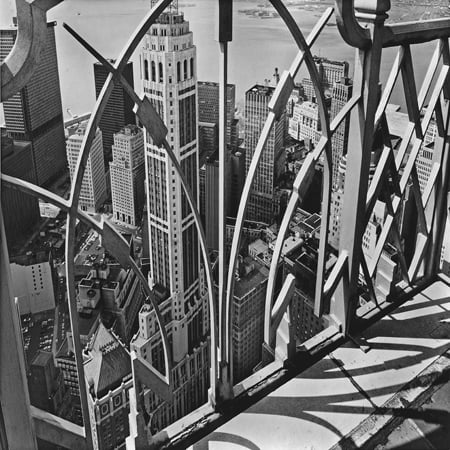
Philip Trager, From the “New York” Series, 1980
Last week was the final chance to see Echoes of Silence: Philip Trager, Early Photographs, 1967–83, which was on view from October 12, 2012, through February 17, 2013, at the New York Public Library’s Stephen A. Schwarzman Building. Located in the Prints and Stokes Galleries, the two long corridors that flank the rotunda on the third floor of the building, the exhibition presented more than 80 of Philip Trager’s early gelatin silver prints, over 20 of which have never before been published or exhibited.
This varied selection provided a thorough introduction to Trager’s work as a preeminent architectural photographer, encompassing examples from several of his notable series, which include a survey of Connecticut homes and buildings, a study of the Wesleyan University campus, and an unfinished commission to document the work of Frank Lloyd Wright. With a straightforward, unassuming style and an eye for geometry, Trager also examines the architectural nuances of cities including Barcelona, Paris, New York, San Francisco, and Taos, New Mexico.
Philip Trager, Guggenheim Museum, 1978
For fellow New Yorkers, perhaps the most interesting images in the exhibition are the stark views of Manhattan in the 1970s, familiar to us yet mysterious at the same time. The photographer captures recognizable landmarks from unusual angles; his images include the triangular Flatiron glimpsed through the arches of the Met Life building, one half of the fountain at Columbus Circle, and a close-up of the Guggenheim rotunda. Trager also photographs the ordinary, often overlooked details of the city, from the sloping front steps of a Harlem brownstone to an ad for Chock Full o’ Nuts above fire escapes in Midtown.
The New York Public Library’s curator of photography, Stephen Pinson, was inspired by Trager’s first book of photographs, Echoes of Silence, which was published in 1972. According to Pinson, “the twelve images in that book are sequenced so beautifully that they somehow seem inevitable. The images possess a quietly relentless formal beauty that informs Trager’s personal vision as a photographer and which, I think, is developed and perfected in his early work.”